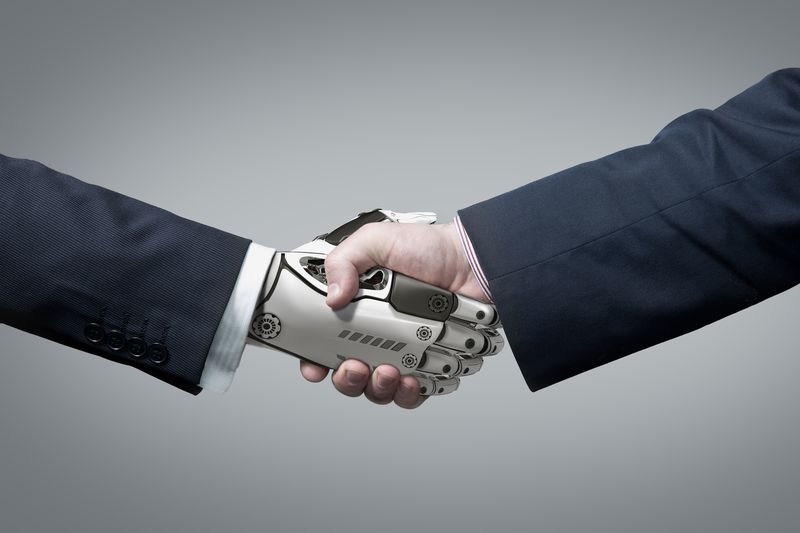The time has already come for robots and humans to work together as a team — collaboratively producing significant results.
Automation cannot be held accountable for entirely taking away jobs; it has also complemented some jobs well. The time has already come when robots and humans are working together as a team – collaboratively producing significant results. At Zume Pizza, a food delivery startup in Mountain View, California, two robots work along with humans as a team in the kitchen.
The two robots, Marta and Bruno, contribute seamlessly to the creation of perfectly cooked pizzas for Zume’s hungry customers. Inside the kitchen, Marta hangs from above in a protective glass box, with spider-like arms that converge and twirl to spread the marinara sauce on a pizza pie. The sauced pie then travels on a conveyer belt to human employees who add cheese and toppings. The decorated pies are then scooped off the belt by the five-feet tall grey coloured, Bruno, who places each pie in an 850-degree oven.

The whole process of getting a finished pizza, with humans and robots working together is a wonderful sight. However, it raises a compelling question — To what extent can this collaboration go? Rajesh Padmanabhan, director & group CHRO, Welspun Group agrees that co-existence will be a working model for sure. “Barring feelings and emotions, AI has become capable of a lot already. But being programmed to figure exchanges of feelings, emotions and empathies, is still in the prototype stage. However, even that will come into place soon,” he says.
No doubt, humanoids or robots are bound to take over various jobs in the workplace — with a lot already being taken over, especially in the manufacturing sector where most tasks are repetitive. Yuvaraj Srivastava, chief human resource officer, MakeMyTrip.com believes that the concept of outsourcing is being disrupted by AI and robotics, as he says, “While outsourcing earlier meant taking a certain work from organisation A to organisation B, the whole paradigm is gradually changing to outsourcing the non-value adding or repetitive tasks to robots.”

Srivastava explains three phases of developments in getting automation and AI into workplaces. The first is the existence of chatbots and assembly-line automation, involving simple yet repetitive tasks. The second is the joint way of working, where the human interface remains intact bringing together man and robot. The third — which may still take long to materialise — is the ability of robots to work independently with all human intelligence and emotions.
In this regard, Padmanabhan says, “Robots can be programmed to read and interpret human emotions and feelings. Soon, a robot may be able to detect my feelings from the pitch and tone of my voice, gauging my mood and discreet intrinsic dispositions. In the future, robots may even make up a majority in the workforce, with lesser humans. There may be a time when humans will need to force-fit themselves into the robotic world.”

On the other hand, Srivastava believes robotics will be useful only in areas where machine learning can really be used. “Robots, till now, have worked on the concept of repetitive insights and behaviours. In case there are behaviours that are difficult to observe, such as human empathy, emotions and feelings, which are all subjective, and what comes under the field of HR as well, machines or robots may not prove useful alone. Hence, that is one area where humans will not be replaced by robots any soon,” he opines.
Even if robots come in as collaborative team members, organisations will certainly need to make efforts to help humans settle into the co-bots culture. As Srivastava explains, the whole concept of working with robots already works well in the manufacturing industry, where it’s more important to be productive and repeatedly correct, and thus, the issues of human interface, interaction and monotony do not arise as much. In corporate jobs, on the other hand, organisations will have to start thinking on the lines of how to keep people engaged when they have robots around.
“Will robots be able to entertain people, play games with them while working, give them performance feedback or start interacting with people to help loosen them up?” Srivastava wonders. However, one thing is for sure — the whole definition of the workplace will change once this happens. As Srivastava says, “When my co-worker will change, my process of engagement will have to change; my ways of looking at well-being will change; and the whole definition of ‘workplace’ will also change.”
Will co-bots extensively enter the workplace? Only time will tell! But with the rapid developments across sectors, it is something that is going to disrupt the concept of the workplace. It is clear that organisations need to gear up to prepare their human workforce to be able to settle in well in the new culture.




1 Comment
No discussion on Robotic deployments can be complete without spelling out what alternate employment avenues are likely to be generated post the shift.
Rushing blindly onto the Robotic street could be OK for a business, but could foment social unrest if the populace fall by the wayside. Social discontent cannot be kept at bay for too long and there’s pretty little governments alone can do.